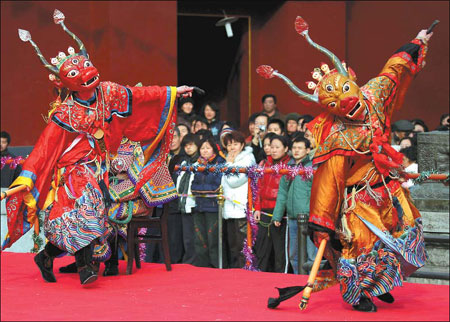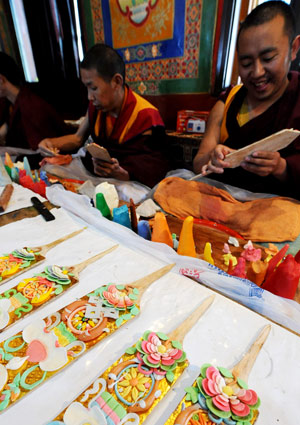 |
|
Lamas perform a traditional Buddhist dance at Yonghe Temple in Beijing yesterday, as part of the celebrations for the Tibetan New Year, which falls Febuary 25.
|
Like the 22-year-old Tibetan herdsman Tashi, Tibetans across China are celebrating the 50th Tibetan new year after the Democratic Reform with their old traditions.
Tashi arrived in Lhasa two days ahead of the new year, which starts on Feb. 25 this year, for the annual Lamaism service called Vajra Dance in Tsurpu Monastery.
 |
|
Tibetan lamas make colorful plates at a lama temple in Lhasa, capital of southwest China's Tibet Autonomous Region, Feb. 19, 2009. These plates are made from butter and will be inserted on Qiema, a two-tier rectangular wooden box containing roasted barley and food prepared with butter, parched barley meal and sugar. Local people are making preparation for the Tibetan New Year, which falls on Feb. 25.
|
"I came here on behalf of my whole family with nine family members," Tashi said. He drove a motorcycle for two hours from the grasslands in Damxung, 70 kilometers away from Lhasa.
"My parents told me that I will have a lucky year if I watch the Vajra Dance at the beginning of a year," he said.
Like many others, Tashi consecrated hada, food and 300 yuan (about 44 U.S. dollars) of donation in front of the Buddha figures.
His family prepared a whole cattle for the new year banquet. They bought clothes and a cellphone as new year gifts for Tashi. "I shot pictures of the dance with the cellphone. I will show them to my family," he said.
Before the Vajra Dance, all the lamas of the monastery chanted the sutra for seven days, praying for a favorable year for the people, said the 40-year-old Dradul, head of the monastery.
"From the 81-year-old experienced chanter to the young lamas, all of us have devoted to the chanting," he said.
Local residents around the monastery set fires to drive away evils and they also enjoyed fireworks in the sky.
"I can only feel the real Tibetan new year when I am back in Tibet," said 70-year-old Shago Khamtrul Yeshe Paldan, who returned to China in 1994 after 28 years in Swiss as a "refugee", being a paper maker, electric worker and nurse successively.
This year is an "earth ox" year in the Tibetan calendar, the 15th new year since he returned home. Except the traditional Tibetan paintings, he also placed bottles of wine in his living room.
On the new year eve, Tibetans have the tradition to watch a TV gala and eat a special food named Gutu, steamed stuffed bun.
The 74-year-old Tsering Drolma put capsicum, wool and china into the buns, representing spicy personality, mild characteristic and lazy bones respectively for the people who eat it in Tibetan traditions.
Tsering Drolma married a man from southwest China's Chongqing Municipality, who is of the Han ethnic group, in the 1950s. She has a big family with four generations now.
"We celebrate both the Spring Festival and the Tibetan New Year each year," she said.
"We eat Gutu to celebrate the Tibetan new year together and my son-in-law comes to make jiaozi for us during the Spring Festival."